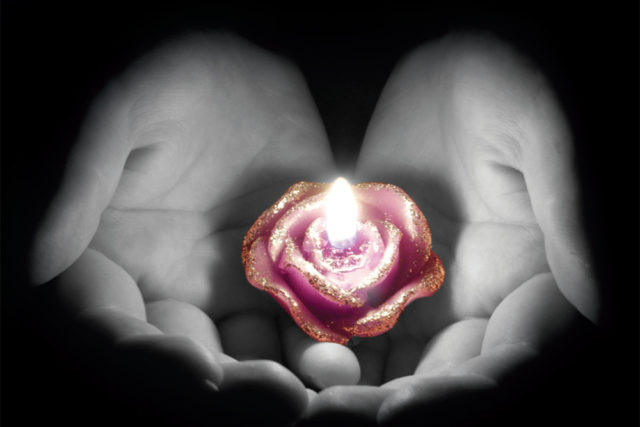According to traditional Indian philosophy there are three main paths to the Divine or “yogas,” described in compelling detail by Lord Krishna in the Bhagavad Gita – the path of knowledge or Gyan yoga, the path of righteous action or Karma yoga, and the path of devotion or Bhakti yoga.
For the purpose of this article I want to discuss the latter two – Karma and Bhakti yoga. Are we better off sitting still and meditating upon the Divine, chanting His name and endeavoring to experience our inherent Oneness with Him, or are we better off getting up and selflessly serving His creation? This question arises quite frequently on the spiritual path – which is more important, sadhana or seva? Will I attain enlightenment, liberation, moksha or the state of Divine Bliss faster in lotus posture with eyes closed or with eyes open, hands working?
Or, is there really any true difference between the two? Are they really two distinct paths?
There is a wonderful story of a devoted man who spent a great deal of time each day in meditation and prayer. One day in his meditation he heard God’s voice commanding him, “There is a large boulder in the field just opposite your house. I want you to push that boulder with all your might.” So the man got up immediately and went into the field. He pushed and pushed, perspired and perspired, but the boulder didn’t budge. Finally, exhausted under the dark sky, he returned home. The following morning before sunrise, eager to complete the Lord’s bidding, he was out in the field again, pushing and pushing. Still the huge boulder did not move an inch. This went on for many days, and then the days became weeks, and the weeks became months. Still the boulder was firm.
Finally, one day the man collapsed in despair. He called out loudly, his voice choking with tears, “My Lord, I have failed You. You gave me such a simple task and even that I was unable to fulfill. I am useless and unworthy of Your favor. Please forgive me.”
The Lord responded lovingly, “My child. I never asked you to move the boulder. I put it there, and thus I am well aware that it cannot be moved by human might. All I asked was that you push against it. In pushing against that boulder for the last several weeks, look at how your arms and legs have strengthened. Do you see the firm muscles where loose flesh had hung before? Look at how healthy your sallow skin tone has become. There is a shine on your skin now, strength in your step, firmness and flexibility in your body. This task was not about moving the rock. It was about molding you. If I wanted the rock moved I would have moved it myself. What I wanted was for you to experience physical labor, for you to feel the sun shine upon your skin, for you to know the fatigue of a hard day’s work and for you to see how much more potential your body has than what you had imagined.”
Many times we mistake the meaning of seva. We think it is about the end, about the goal, about success. We see it as a task before us that we undertake with the feeling of generosity or devotion. However, seva is purely sadhana in an active form. Seva serves two specific purposes: aside from the actual benefit to the poor of the schools, hospitals, orphanages we may build. The first benefit is that it teaches and trains us to see the Divine in all. Seva is not about “us” serving “them.” It is not about “we” who are privileged giving to “they” who are disadvantaged. Seva is a practice of seeing them as us. Every religion in the world teaches us that we are all One. Hinduism says, “Vasudhaiva Kutumbakam” (the world is one family). Christianity says, “Love thy neighbor as thyself.” This does not mean that I love cookies so I should feed my neighbor cookies. In order to truly, deeply and fully love another being as myself, I must see that person as myself and see myself in them. Otherwise, we can never love another as much or in the same way as we love ourselves. The only way is to see the other as self.
The word yoga literally means “union.” It is a union of the self with the Divine. Whether one walks the path of Karma yoga, Bhakti yoga, Gyan yoga or practices Mantra yoga or Siddhi yoga or Laya yoga or Raja yoga, it doesn’t matter. The destination is the same. They are all “yoga” or practices of union. In each of these practices we are striving to realize the union of ourselves with the Divine, and the moment we have a glimpse of union with the Divine, immediately we realize a union with all of creation. God is not partial. God would never say, “I’ll be One with you and you, but not with you.” The scriptures implore us to realize that we are One with God, and they never say, “But only if your name is included at the end of this book.” No, we are all One with the Divine, and if we are all One with God then, by definition, we are One with each other. If A equals B and B equals C, then by definition A equals C. So, if I am One with God and you are One with God then you and I are One with each other.
That Oneness with the Divine and through the Divine with all of creation is the fruit of true sadhana. So when we serve others in seva, when we work for the benefit of the world, on any level, through any means, the goal is not about the particular fulfillment of a project. The goal is to see the Divine in all whom we are serving – whether a child, a woman, a patient, a cow or a river. When we see the Divine in those whom we are serving then of course we will work with sincerity, focus, attention, dedication and commitment.
The other important aspect of seva is how it shapes us. Like the man in the story, seva is what tunes us and tones us, not just the body – the mind, thoughts, and ego. It is one thing to sit in meditation and feel ego less; it is another to serve in the world with no ego. It is one thing to find a state of peace and stillness of the mind sitting silently in a forest or temple. It is quite another to find that same state of peace and stillness in the midst of a major seva project. That is the goal. The joy, peace, oneness, and divine connection we feel in meditation and prayer is what we carry with us into the day of seva. Just as we see the Divine in the images in our temple, can we see the same Divine in everyone with whom we interact, in everyone and everything for whom and with whom we are serving?
So, seva and sadhana, Karma yoga and Bhakti yoga go hand in hand, and—in the higher levels of awareness—merge into one. After all, is loving someone any different from bringing him/ her a cup of tea? Is loving someone any different from wiping his/her feverish brow? Of course not. There is no way to determine where love ends and service begins. When the love is true and pure, service is the most natural outcome. Hence, when the sadhana is true, seva is the natural extension of it. Conversely, through seva we attain a state of love and unity which deepens and enriches our sadhana. Slowly we realize, they are simply two sides of the same coin, two streams meandering and merging together into the one great Ocean.







